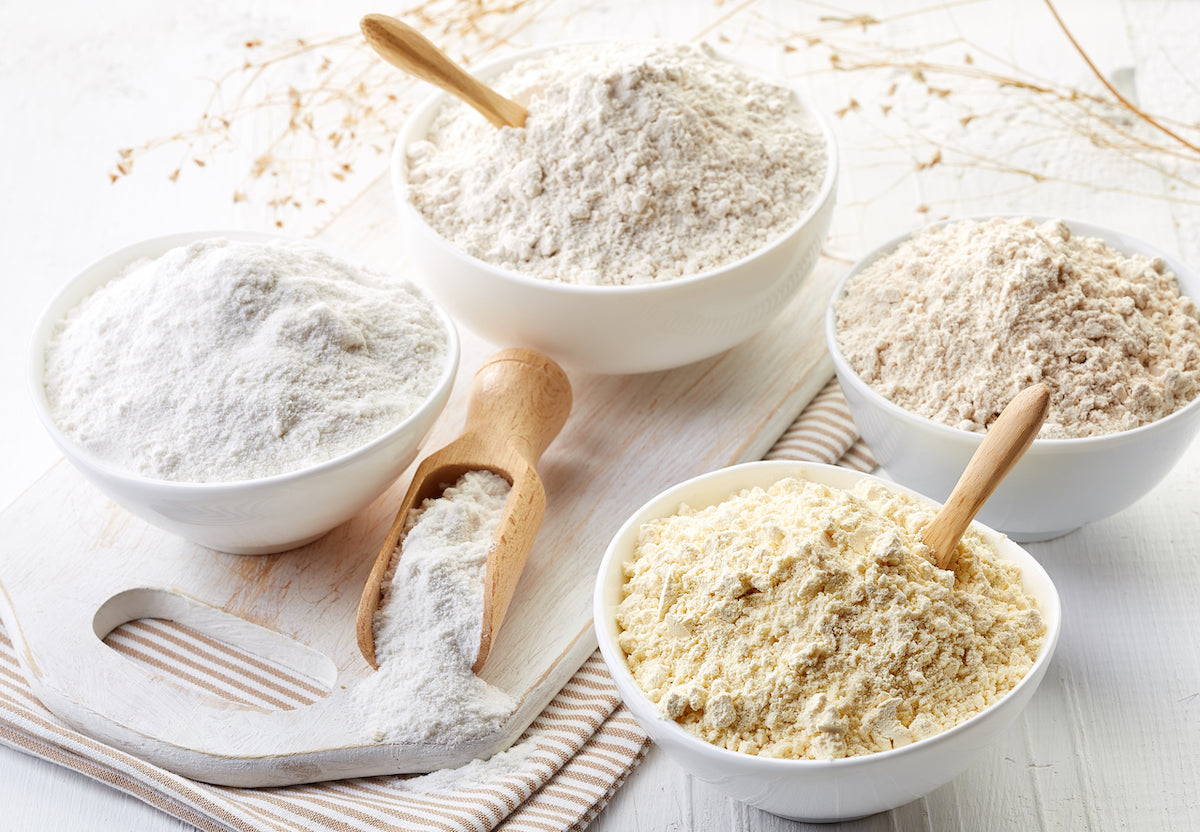
Quick Take
Whether you're gluten intolerant, diagnosed with celiac, suffer from inflammation, or just curious in the kitchen, gluten-free baking can be fantastic when done right.
Before We Begin: We Baked You a Gluten-Free Treat
Living gluten-free doesn't mean living treat free! Add a MamaSezz High Protein Breakfast Bar to your next MamaSezz order and satisfy your sweet tooth, no gluten necessary. FULL DISCLOSURE: This gluten-free breakfast bar is essentially a maple, vanilla blondie based topped with brownie batter. 100% gluten-free, 100% vegan, 100% delicious. You're welcome.
On This Page
Our 4 Favorite Gluten-free Flours (and When to Use Them)
The Gluten-free Flour Tips Every Beginner Needs to Know
3 Easy Plant-Based Desserts Using Gluten-free Flour
Key Takeaways
Our 4 Favorite Gluten-free Flours (and When to Use Them)

1. Oat Flour
Oat flour has a nutty flavor and is great for adding density and bulk to your recipe. It gives baked goods a chewier, crumblier texture than all-purpose flour. (Note: some oats are not certified gluten-free so double check that before you use...and even then, folks with true gluten sensitivity or those with celiac can't tolerate oats so be cautious.)
Best for: cookies, quick breads.
Substitution ratio: Use 1 1/3 cup of oat flour for every 1 cup of traditional flour for cookies and quick breads. (Note: oat flour doesn't work as well as a replacement for all-purpose flour in recipes that need the gluten to rise, like yeast breads.)
Make oat flour at home: Blend rolled oats in the food processor or blender until it becomes granular.
2. Almond Meal
Almond meal (as opposed to almond flour*) is nutty, rich, and hearty.
Best for: Baked goods, substitute for breadcrumbs
Substitution ratio: Use about twice as much almond meal/almond flour than you would traditional flour. Almond flour is best however used in recipes that call for almond flour rather than just swapping out regular flour.
Make almond meal at home: Blend raw almonds in the food processor until granular. Do not over blend or you will make nut butter. Shake blender frequently during the process.
*What's the difference between almond meal and almond flour? Almond flour is usually made from blanched almonds with skins removed and is finely ground. Almond meal is a little courser because it still has the skins when ground. Although they're slightly different in texture, you can use them interchangeably in recipes.
3. Brown Rice Flour
Brown rice flour is light, grainy, and has a mild earthy flavor. It's high in fiber because it's ground from rice that still has the bran and germ attached. It's heavier than white flour.
Best for: adding crispiness to cookies, thickener for sauces/soups.
Substitution ratio: You can substitute for traditional wheat flour with a 1:1 ratio when using brown rice flour as a thickener in sauces and soups. When using brown rice flour in baked goods, you may need to use some extra liquid to prevent your treat from drying out.
4. Chickpea Flour
Chickpea flour is savory, bitter, starchy and smooth. It is dense and is better for savory dishes that need structure versus sweet baked goods.
Best for: tortillas, egg-free frittatas, flatbreads, crepes.
Substitution ratio: Use 3/4 cup of chickpea flour in place of 1 cup of all-purpose flour. You can use a 1:1 ration when substituting in place of heavier flours, like rye or spelt.
The Gluten-free Flour Baking Tips Every Beginner Needs to Know

If you’re replacing wheat flour with gluten-free flour, there are a few tips you can use to make sure your recipe comes out fantastic, every time.
1. Combine Flours
Use a combo of 2 or more gluten-free flours when baking. If you just use one, you may find it will change the consistency, texture, and even flavor of your baked-good.
2. Use Additional Binders When Baking
Add one of the following ingredients to your gluten-free flour mix (about 1 or 2 Tablespoons per cup of flour):
- Ground flaxseed
- Ground chia seed
- Potato starch
- Garbanzo flour
- Tapioca Starch
3. Keep It Simple If You're New to Gluten-Free Baking
Try not to get overwhelmed. Baking is supposed to be fun! If you're new to gluten-free baking, start with simple recipes like pancakes and minimal ingredient cookies.
4. Make Baked Goods a Bit Smaller
Gluten-free flours tend to yield crumblier baked goods. To prevent your treat from falling apart, aim to make slightly smaller baked goods helps them stick together.
3 Easy Plant-based Desserts Using Gluten-free Flour
1. Breakfast Oatmeal Muffins
These easy healthy muffins are made with homemade oat flour (it's so easy to make at home, promise!) - and are the perfect on-the-go breakfast.
2. Vegan Double Chocolate Cake
This cake uses a classic gluten-free flour combo: almond flour and coconut flour and blended beets (MamaSezz Strong Heart Beets). The results? One moist, chocolatey, delicious whole food treat. Indulge!
3. Whole Food Plant Based Oatmeal Raisin Cookies

Another delicious gluten-free baked good using a combination of gluten-free flours: oat flour and brown rice flour. This whole food plant based and gluten-free take on oatmeal raisin cookies is full of fiber and nutrients.
Key Takeaways
- There are plenty of gluten-free flours to choose from. We love to use oat flour for cookies and quick breads, almond meal/almond flour in baked goods or as a substitute for breadcrumbs, brown rice flour to add crispiness to vegan cookies or to thicken sauces and soups, and chickpea flour for savory dishes that require structure, like egg-free frittatas.
- New to gluten-free baking? We suggest you get used to combining different types of gluten-free flours, adding more binders than traditional flour recipes, keep it simple and stick to pancakes and cookies at first, and try making your gluten-free baked goods a little smaller to prevent crumbling.
- Rather not do the gluten-free baking yourself? No problem. Add MamaSezz High Protein Breakfast Bars (essentially, a breakfast brownie/blondie combo) to your next MamaSezz order for a delicious gluten free baked treat.
By The MamaSezz Team



